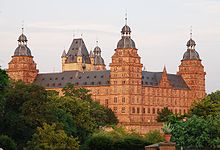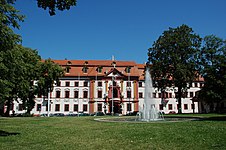Electorate of Mainz
Prince-Archbishopric of Mainz Kurfürstentum Mainz ( Latin ) | |||||||||||||||||
|---|---|---|---|---|---|---|---|---|---|---|---|---|---|---|---|---|---|
| 780–1803 | |||||||||||||||||
Roman Catholicism | |||||||||||||||||
| Government | Ecclesiastical principality | ||||||||||||||||
| Prince-elector and Archbishop | |||||||||||||||||
• 754–786 | Lullus (first) | ||||||||||||||||
• 1802–1803 | Karl Theodor von Dalberg (last) | ||||||||||||||||
| Historical era | |||||||||||||||||
• German Mediatisation | 1803 | ||||||||||||||||
| |||||||||||||||||
| Today part of | Germany | ||||||||||||||||
The Electorate of
The Archbishop-Elector of Mainz was also
History

The episcopal see was established in ancient Roman times in the city of Mainz, which had been a Roman provincial capital, Moguntiacum. The first bishops before the 4th century have legendary names, beginning with Crescens. The first verifiable Bishop of Mainz was Martinus in 343. The ecclesiastical and secular importance of Mainz dates from the accession of St.
The territory of the Electorate included several non-contiguous blocks of territory: lands near Mainz on both the left and right banks of the Rhine; territory along the Main River above Frankfurt (including the district of Aschaffenburg); the Eichsfeld region in Lower Saxony and Thuringia; and the territory around Erfurt in Thuringia.
As was generally the case in the Holy Roman Empire, the territory of a prince-bishopric or archbishopric differed from that of the corresponding diocese or archdiocese, which was the purely spiritual jurisdiction of the prince-bishop or archbishop. During the early modern age, the archdiocese of Mainz (see map below) was the largest ecclesiastical province of Germany, covering Mainz and 10 suffragant dioceses.[3]
In 1802, Mainz lost its archiepiscopal character. In the secularizations that accompanied the
The modern Roman Catholic Diocese of Mainz was founded in 1802 when Mainz lost its archdiocese status and its territory west of the Rhine River became a mere diocese within the territory of France. In 1814 its jurisdiction was extended over the territory of Hesse-Darmstadt. Since then it has had two cardinals and via various concordats was allowed to retain the medieval tradition of the cathedral chapter electing a successor to the bishop.
-
Schloss Johannisburg in Aschaffenburg
-
Palace of the Mainz Governors in Erfurt
-
Erfurt Cathedral and St. Severus Church in Erfurt
See also
References
- ^ Lafage, p. 69
- ^ Sante, Georg Wilhelm (1937). "Bonifatius und die Begründung des Mainzer Bistums". Historisches Jahrbuch (in German). 57: 157–97.
- ^ Augsburg, Coire, Constance, Eichstätt, Hildersheim, Paderborn, Speyer, Strasbourg, Worms, Würtzburg; Franck Lafage, Les comtes Schönborn, 1642–1756, L'Harmattan, Paris, 2008, vol 1, p. 69
External links
- Official website of the modern Diocese
- Map of the Archbishopric of Mainz in 1789










